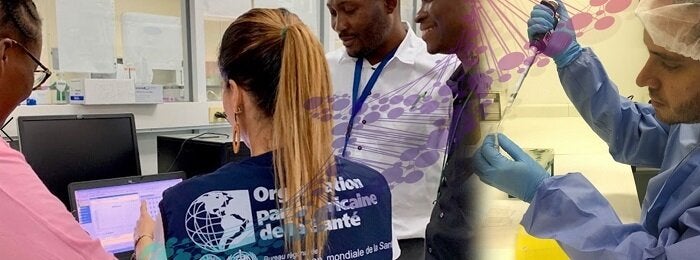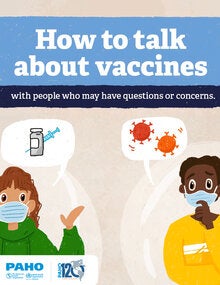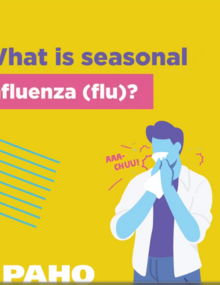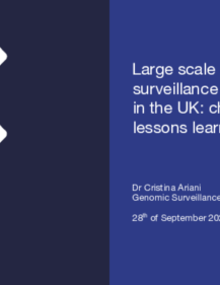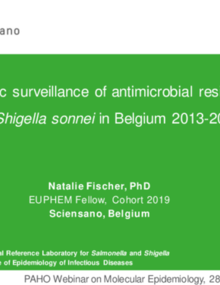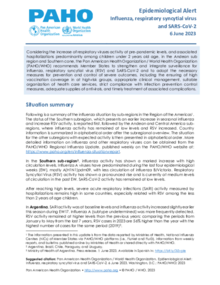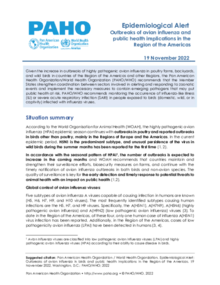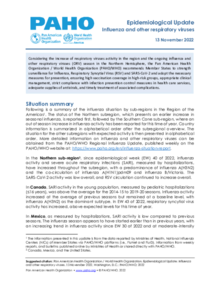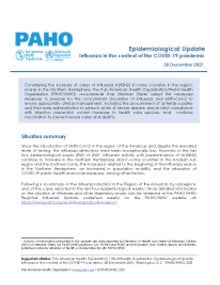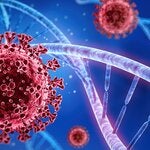Influenza is a viral infection that affects mainly the nose, throat, bronchi and, occasionally, lungs. Infection usually lasts for about a week and is characterized by sudden onset of high fever, aching muscles, headache, and severe malaise, non-productive cough, sore throat, and rhinitis. The virus is transmitted easily from person to person via droplets and small particles produced when infected people cough or sneeze. Influenza tends to spread rapidly in seasonal epidemics. Most infected people recover within one to two weeks without requiring medical treatment. However, in the very young, the elderly, and those with other serious medical conditions, infection can lead to severe complications of the underlying condition, pneumonia, and death.
SARS-CoV-2 is the virus that causes the infectious disease known as Coronavirus (COVID-19). Most people infected with the virus will experience mild to moderate respiratory illness and recover without requiring special treatment. However, some will become seriously ill and require medical attention. Older people and those with underlying medical conditions like cardiovascular disease, diabetes, chronic respiratory disease, or cancer are more likely to develop serious illness. The virus can spread from an infected person’s mouth or nose in small liquid particles when they cough, sneeze, speak, sing or breathe. Anyone can get sick with COVID-19 and become seriously ill or die at any age.
Respiratory syncytial virus, or RSV, is a common respiratory virus that usually causes mild, cold-like symptoms. Most people recover in a week or two, but RSV can be serious. Infants and older adults are more likely to develop severe RSV and need hospitalization. Vaccines are available to protect older adults from severe RSV. Monoclonal antibody products are available to protect infants and young children from severe RSV.
All age groups can be affected but there are groups that are more at risk than others.
- People at greater risk of severe disease or complications when infected are: pregnant women, children under 59 months, the elderly, individuals with chronic medical conditions (such as chronic cardiac, pulmonary, renal, metabolic, neurodevelopmental, liver or hematologic diseases) and individuals with immunosuppressive conditions (such as HIV/AIDS, receiving chemotherapy or steroids, or malignancy).
- Health care workers are at high risk of acquiring influenza virus infection due to increased exposure to the patients and risk further spread particularly to vulnerable individuals.
In terms of transmission, seasonal influenza spreads easily, with rapid transmission in crowded areas including schools and nursing homes. When an infected person coughs or sneezes, droplets containing viruses (infectious droplets) are dispersed into the air and can spread up to one meter, and infect persons in close proximity who breathe these droplets in. The virus can also be spread by hands contaminated with influenza viruses. To prevent transmission, people should cover their mouth and nose with a tissue when coughing, and wash their hands regularly.
In temperate climates, seasonal epidemics occur mainly during winter, while in tropical regions, influenza may occur throughout the year, causing outbreaks more irregularly.
The time from infection to illness, known as the incubation period, is about 2 days but ranges from one to four days.
- There are 4 types of seasonal influenza viruses, types A, B, C and D. Influenza A and B viruses circulate and cause seasonal epidemics of disease.
- Influenza A viruses are further classified into subtypes according to the combinations of the hemagglutinin (HA) and the neuraminidase (NA), the proteins on the surface of the virus. Currently circulating in humans are subtype A(H1N1) and A(H3N2) influenza viruses. The A(H1N1) is also written as A(H1N1)pdm09 as it caused the pandemic in 2009 and subsequently replaced the seasonal influenza A(H1N1) virus which had circulated prior to 2009. Only influenza type A viruses are known to have caused pandemics.
- Influenza B viruses are not classified into subtypes but can be broken down into lineages. Currently circulating influenza type B viruses belong to either B/Yamagata or B/Victoria lineage.
- Influenza C virus is detected less frequently and usually causes mild infections, thus does not present public health importance.
- Influenza D viruses primarily affect cattle and are not known to infect or cause illness in people.
- Seasonal influenza is characterized by a sudden onset of fever, cough (usually dry), headache, muscle and joint pain, severe malaise (feeling unwell), sore throat and a runny nose. The cough can be severe and can last 2 or more weeks. Most people recover from fever and other symptoms within a week without requiring medical attention. But influenza can cause severe illness or death especially in people at high risk.
- Illnesses range from mild to severe and even death. Hospitalization and death occur mainly among high-risk groups. Worldwide, these annual epidemics are estimated to result in about 3 to 5 million cases of severe illness, and about 290 000 to 650 000 respiratory deaths.
- In industrialized countries, most deaths associated with influenza occur among people age 65 or older. Epidemics can result in high levels of worker/school absenteeism and productivity losses. Clinics and hospitals can be overwhelmed during peak illness periods.
- The effects of seasonal influenza epidemics in developing countries are not fully known, but research estimates that 99% of deaths in children under 5 years of age with influenza-related lower respiratory tract infections are found in developing countries.
- Framework of a national program for preventing and controlling diseases caused by respiratory viruses with epidemic and pandemic potential
- Preparedness and resilience for emerging threats: Module 1: planning for respiratory pathogen pandemics
- Regulation of the prevention, surveillance and control of respiratory viruses with epidemic and pandemic potential (Only available in Spanish)
- Global Epidemiological Surveillance Standards for Influenza. WHO;2014
- Operational Guidelines for Sentinel Severe Acute Respiratory Infection (SARI) Surveillance; 2014
- Global Influenza Strategy 2019-2030
- End-to-end integration of SARS-CoV-2 and influenza sentinel surveillance: revised interim guidance
- Final report Ad hoc expert consultation in the Region of the Americas: Challenges, gaps and next steps in COVID 19 surveillance and its integration into influenza and other respiratory viruses surveillance
- Influenza and Other Respiratory Viruses: Surveillance in the Americas 2021
- Epidemiological Alert - Influenza, respiratory syncytial virus and SARS-CoV-2 - 6 June 2023
- “Crafting the mosaic” A framework for resilient surveillance for respiratory viruses of epidemic and pandemic potential (Also available in French here and Portuguese here)
- National Influenza Centres
- Operational guidance for sharing seasonal influenza viruses with WHO Collaborating Centres
- Influenza and SARS-CoV-2 integrated surveillance laboratory testing algorithm (Available also in French)
- Samples from patients suspected of Influenza A/H5 LABORATORY TESTING ALGORITHM ( Also available in Portuguese)
- Protocol RSV laboratory diagnosis: positive control (gblock – RSV)
- Respiratory Syncytial Virus (RSV) laboratory diagnosis Technical note
- Respiratory sample collection for Influenza and other respiratory viruses diagnosis - Infographic
- Clinical care for severe acute respiratory infection: toolkit: COVID-19 adaptation (2020)
- WHO Model List of Essential Medicines for Children - 9th list (2023)
- Guidelines for the clinical management of severe illness from influenza virus infection (2021)
- Clinical management of COVID-19: Living guideline, 18 August (2023)
- Clinical care for severe acute respiratory infection: toolkit: COVID-19 adaptation (2020)
- SARI Clinical Management: Identifying High-Risk Patients - Video
- SARI Clinical Management: Prone Maneuveur - Video
- SARI Clinical Management: Mechanical Ventilation Basics - Video (Only available in Spanish)
- SARI Clinical Management: Mechanical Ventilation Advanced - Video (Only available in Spanish)
- SARInet training Experience for Clinical Management Care - Video (Portuguese, Spanish and English)
- Use of Personal Protection Equipment and Hand Washing (Only available in Spanish)
- Readiness for influenza during the COVID-19 pandemic: policy brief, 6 November 2020
- WHO SAGE Seasonal Influenza Vaccination Recommendations during the COVID-19 Pandemic
- Highlights from the Meeting of the Strategic Advisory Group of Experts (SAGE) on Immunization, 2021
- Guidelines for the clinical management of severe illness from influenza virus infections, WHO. 2022
- Considerations for implementing and adjusting public health and social measures in the context of COVID-19
- Influenza at the Human-Animal Interface: PAHO Recommendations to Strengthen Intersectoral Work for Surveillance, Early Detection, and Investigation, 2020
- Avian and Human Pandemic Influenza: Addressing the Need for Integration between Health and Agriculture in the Preparedness Plans in Latin America
- Strengthening Intersectoral Work for Influenza in the Human-Animal Interface in the Region of the Americas. May 2023: Technical Questions and Answers. May 2023.
- Epidemiological Alert: Outbreaks of avian influenza caused by influenza A(H5N1) in the Region of the Americas
- Strengthening the intersectoral work for Influenza at the Human Animal Interface in the Region of the Americas: Technical Questions and Answers
- Report of the Regional Consultation for the Strengthening of Intersectoral Work in the Human-Animal Interface of Influenza. March 2023
- Joint Risk Assessment Operational Tool (2021)
- Public health resource pack for countries experiencing outbreaks of influenza in animals (2023)
- PIP PC Preparedness High-Level Implementation Plan II 2018-2023
- Strengthening Pandemic Preparedness Planning for Respiratory Pathogens Policy Brief (New)
- Preparedness and resilience for emerging threats: Module 1: planning for respiratory pathogen pandemics (New)
- Response to Pandemic (H1N1) 2009 in the Americas: Lessons and Challenges (2010)
- Regional Workshop on Lessons Learned about Preparedness and Response during the COVID-19 Pandemic in the Region of the Americas - Buenos Aires, 16 to 19 of August 2022. (New)
The organization supports countries in the surveillance, prevention, preparedness, and control of pandemic & epidemic-prone diseases through the development of evidence-based strategies to predict, prevent, detect, and respond to infectious hazards. It also ensures regional surveillance functions related to these hazards.
Major Action Lines:
- Pandemic & epidemic-prone diseases: Influenza, MERS, hemorrhagic fevers and hantavirus, yellow fever & emerging arboviruses, plague, cholera & epidemic-prone diarrheal diseases, leptospirosis, meningococcal disease.
- Expert networks and interventions for surveillance and response: epidemiology and modeling, laboratory, clinical management, and infection prevention & control.


